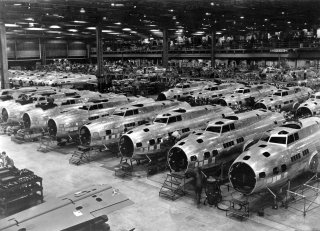Joined at the Hip: Deterrence, Productive Capacity, and Ukraine
The Western response in Ukraine has revealed crucial American and Western vulnerabilities in the re-emergence of defense industrial warfare in the new international powerplays.
Ukraine’s defensive war against Russia, if successful, is going to have an impact every bit as epochal as Iraq’s 1991 eviction from Kuwait or Argentina’s forced departure from the Falklands in 1982, to name just a few salutary lessons delivered to aggressive states.
Over the years, crises big or small have periodically defined the international “system” for good or ill. Think also of Suez Crisis in 1956, or the 1938 capitulation to Adolf Hitler at Munich.
Does the current yearlong response by Ukraine’s allies, most of them grouped in NATO, have a similarly defining effect? To be sure, the Western response has delivered economic pain to Russia, and critically important intelligence and munitions to Ukraine. But do the results add up to a convincing display of deterrence and resolve?
The Western coalition in Ukraine is seen as also deterring China from attacking neighboring countries, notably China’s “renegade province,” Taiwan. But is it doing that? The answer is mixed, not least because the spotlight we have put on our response in Ukraine has revealed crucial American and Western vulnerabilities.
The weaknesses lie in the re-emergence of defense industrial warfare in the new international powerplays. The year-long war in Ukraine has spawned profligate artillery and rocketry duels, in numbers not seen since the last world war.
After a year’s fighting, keeping ammunition stocks and fighting vehicles sufficiently plentiful and routinely upgraded seems the challenge which will determine the course of the war and its outcome. For months, drone footage and satellite imagery have shown us leveled cities and pock-marked fields, recalling artillery and bomb-scarred moonscapes of the first and second world wars.
In November, the U.S. Department of Defense calculated that Russia was firing 20,000 artillery shells a day. The numbers expended by the Ukrainians had meanwhile reached up to 7,000/day. With these rates of fire, stocks are becoming exhausted, on both sides. For Ukraine’s allies, there is also a draining effect. How can stockpiles be reliably replenished to keep the Ukrainians in the field?
The challenge must not be minimized. In December, the Royal United Services Institute said that Russia, in just two days of that month, had used more ammunition than that contained in the entire stock of the British military. And while the United States has much larger stockpiles of weapons and munitions, the Pentagon recently decided to boost six-fold the production of critically important 155-millimeter shells. Just ten days of fighting in January had outpaced current production.
This explains the Pentagon’s searching high and low for stores of munitions. It has sought munitions from Israeli and South Korean stockpiles, straining to keep up with Ukrainian demand. The Pentagon’s chief acquisition officer, Bill Laplante, put it succinctly a few months ago: “[Ukraine] has focused us ... on what really matters, and what matters is production.”
In recent years, of course, production shortfalls and delivery impediments have afflicted our own and others’ economies. The past allure of “just-in-time” warehousing and other minimalist stocking practices have weakened our industrial resilience. Acquisition shortfalls typify the broader status quo, a state of industrial complacency going far beyond shortages of specific munitions or war-fighting gear.
America’s military-industrial base has become as vulnerable as the wider economy. The supply chain crisis now afflicts everything, from specific weapons systems to the basic materials for developing affordable clean energy technologies. The Ukraine War highlights our dependence on Chinese manufacturing, the beneficiary of outsourcing decisions frustrating immediate supply (and re-supply) needs. Whether for narrow defense manufacturing, or much broader consumer goods, industrial supply chains have become stubbornly vulnerable to disruption—be this from pandemics, civil unrest half a world away, or the machinations of geopolitical rivalry.
The data reveals the weakness. Productive capacity in the United States for all essential goods and materials falls well short of minimally acceptable capacity. Laplante singles out the lagging supply of rare earth elements (REE), describing a China controlling 80 percent of global REE as decades ahead in developing the type of supply chains we need.
Apart from rare earths, China controls most of the battery metals which underpin rapidly advancing electric vehicle (EV) production. Building American EV capacity, from the mine to the assembly line, has become a national must-do—lest we find the United States and other Western economies locked out of the new transportation paradigm.
Apart from its fighting forces, America’s greatest role during World War II emerged as the “arsenal of democracy.” U.S. industry provided nearly two-thirds of all Allied military equipment during the war—specifically 297,000 aircraft, 193,000 artillery pieces, 86,000 tanks, and two million army trucks. By the war’s end, the United States had become home to more than half of the world’s entire industrial production.
Today, only one economy has the productive capacity to rival what the United States then achieved: China. The Chinese generate over thirty percent of total global manufacturing, producing, in particular, more than half of the world’s raw steel, three-fourths of all lithium-ion batteries, and four-fifths of all the world’s solar panels. China’s manufacturing dominance may not be, on its own, a “threat,” but our naked dependence on Chinese supply chains counts as a terrible vulnerability.
Thankfully, Congress and the Biden administration, have become alert to this problem. Beginning in the previous administration and continuing into today’s, we find ourselves once again in a world of great power competition.
Facing this reality requires new investment in our entire industrial base, not in just especially favored defense industries. We need to see it holistically, as all of one piece, a regaining of the capacity underpinning our economic, energy, and national security. Beyond the present war, that is the best way to project deterrence.
James Clad is a former U.S. Deputy Assistant Secretary of Defense for Asia-Pacific Security Affairs.
Image: United States Department of Defense.

